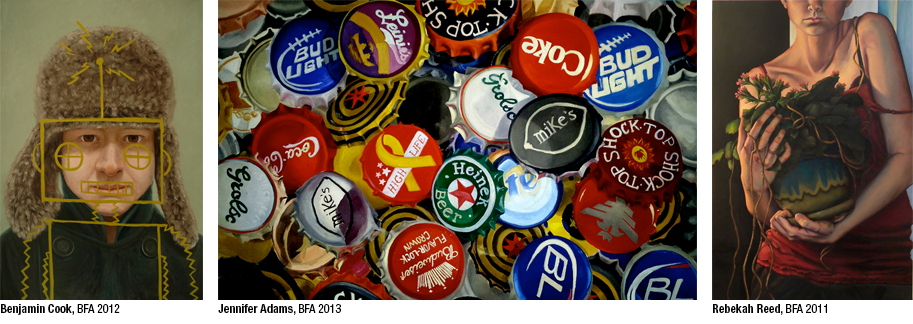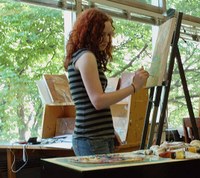BFA Studio Art Track
The Studio Art track allows students to customize their degree to either focus primarily on a specific studio area — Ceramics, Drawing, Glass, Painting, Printmaking, Photography, or Sculpture— or to work cross-media taking courses in several studio areas.
In addition to the basic requirements of the BFA, students in the Studio Art BFA track will take 15 hours of courses at the 500-level in studio art, plus 15 hours of 300-level or above studio art or art history electives.
Ceramics
Taught within the context of a broad liberal arts curriculum, the ceramics program places strong emphasis on developing a repertoire of fundamental techniques that give students a basis for further experimentation.
An unusually high number of our graduates continue to work professionally in the field, teaching and supporting themselves as ceramicists.
The program has studio facilities equipped with throwing, hand-building, and firing clay, with electric and gas kilns for high temperature reduction techniques.
In addition to the regular course offerings with our faculty, we feature annual workshops conducted by internationally acclaimed artists.
For further information regarding the Ceramics Program, please contact:
Lalana Fedorschak, M.F.A.
Assistant Professor, Term
Email Lalana Fedorschak
Phone: 502.852.6794
Drawing

The Drawing area offers professional, studio-based training in intermediate and advanced courses for students who wish to pursue drawing as an area of specialization or to develop their drawing skills in contemporary practice. At the University of Louisville, art + design students also have the advantages of a well-rounded liberal arts university education supported by courses in aesthetics, cultural studies, women and gender studies, sociology, and anthropology to deepen their understanding of current human conditions and strengthen their concept in art making.
Previous BFA drawing theses include a variety of themes and concepts, including the human figure, animals, plants, landscape and architecture, abstraction, mixed media, working with AI-generated images, video and animation projection, and installation.
We encourage our BFA students to create an innovative combination of mediums by combining drawing with painting, printmaking, photography, digital media, fiber, sculpture, and installation in contemporary art making.
[ View drawing student work ]
For further information regarding the Drawing Program, please contact:
Ying Kit Chan, M.F.A.
Professor
Email Ying Kit Chan
Phone: 502.852.0806
Webpage: Professor Ying Kit Chan
Glass
The Glass Program employs a comprehensive approach to educate undergraduate and graduate students in the fundamentals of glass art. The curriculum encourages students to develop a strong technical foundation in the hot, cold, and warm glass areas. At the same time it emphasizes the importance of an intellectual approach to making contemporary art utilizing glass. Courses in glass utilize in-studio demonstrations and exercises to impart an understanding of glassmaking processes. Additionally, there is an equal component of classroom discussions, presentations, and critiques which familiarizes students with the historical and contemporary context of glass art.
The program highlights the importance of critical thinking and problem solving to help students achieve breadth of content and concept in their creative endeavors. A healthy visiting artist program ensures that students are exposed to a variety of approaches to working with and thinking about glass.
The Hite Art Institute offers Introduction to Glassmaking at the 300 level which serves to introduce students to a variety of glass processes including glass blowing, kilnworking, and coldworking. Among other things, students learn to blow, cut, grind, cast, and polish glass in this course. Additionally, students will begin to practice using glass to investigate sophisticated ideas, concepts, and content.
At the 500 level, Intermediate and Advanced Glassmaking focuses on delving deeper into creative, experimental, and conceptual approaches to working with glass. At the same time, students are expected to increase the technical level of execution of their work and advance their understanding of the context of glass and art.
Classes are taught downtown at the Cressman Center, on the corner of First and Main.
Links:
Professor Ché Rhodes
Professor Ché Rhodes named Educator of the Year
Renowned UofL glass artist has piece added to Smithsonian
For further information regarding the Glass Program, please contact:
Ché Rhodes, M.F.A.
Associate Professor
Email Ché Rhodes
Phone: 502.852.0277
Painting

The painting program offers instruction at all levels. Based upon the premise that excellent painting may occur within a tradition, or outside of it, our program adheres to no single school of thought, but is structured to allow students to begin to develop their own vision through disciplined training.
While beginning painting students are given a solid foundation in the discipline, advanced students, depending upon their respective stages of development, are encouraged to explore avenues of expression pertinent to their own interests. A primary objective of the program is to encourage awareness among students that learning about oneself and the world in which one lives is as important as developing visual skills. Large studios with north light afford painting students on all levels ample working space. Studios remain open for student use at times other than class hours. An open area in advanced painting is reserved for viewing paintings in progress and for critiques. Models are available for those students involved in figurative work.
Large studios with north light afford painting students on all levels ample working space. Studios remain open for student use at times other than class hours. An open area in advanced painting is reserved for viewing paintings in progress and for critiques. Models are available for those students involved in figurative work.
The department's Visiting Artists Program brings notable painters to campus to speak about their own work and to critique students efforts.
[ View painting student work ]
For further information regarding the Painting Program, please contact:
Mark Priest, M.F.A.
Professor
Email Mark Priest
Phone: 502.852.1016
Megan Bickel, M.F.A.
Assistant Professor, Term
Email Megan Bickel
Phone: 502.852.0803
Printmaking
The printmaking program provides breadth and versatility through both its facilities and its faculty. Students are instructed in all traditional printmaking processes: relief (Woodcuts and Linocuts), Intaglio (Etching and Engraving), Serigraphy (Silkscreen), and Lithography; and are also able to work with newer technologies such as photo processes and computer designs.
The printmaking program currently has a digital lab (Mac-based), complete with medium format color printer, laser printer, and scanner. Students use this equipment to combine digital imaging with traditional printmaking methods. Digital imaging is an excellent tool for doing preparatory work for traditional print processes.
The program emphasizes personal expression and encourages original and serious contemporary concepts in printmaking. Students are encouraged to develop historical perspective in their work, as well as, consider the works of contemporary artists.
 The Visiting Artists Program brings nationally recognized professionals and scholars in historical, contemporary and technical areas of printmaking to campus each year to lecture about their work, demonstrate special techniques, and work one on one with students. Field trips to important print exhibitions and to museums are also a feature of the program.
The Visiting Artists Program brings nationally recognized professionals and scholars in historical, contemporary and technical areas of printmaking to campus each year to lecture about their work, demonstrate special techniques, and work one on one with students. Field trips to important print exhibitions and to museums are also a feature of the program.
[ View printmaking student work ]
For further information regarding the Printmaking Program,
please contact:
Rachel Singel, M.F.A.
Assistant Professor
Email Rachel Singel
Phone: 502.852.0828
Photography

The photography program explores the unique qualities of the medium and its possibilities for personal expression. Through a series of visual assignments, students experiment with the various reasons for making photographs: as documents, as images designed and directed by the photographer, and as social commentary. Instruction is tailored to the individual students needs and abilities with the hope that each one will find her or his own voice.
Students learn fundamental camera, darkroom and electronic imaging skills necessary for convincing picture making. While photographic technique is stressed, emphasis is always given to ideas and how to make those ideas visual and exciting.
In addition to the studio courses, photography students are encouraged to take a class in the history of photography. The photographic facilities include a large twenty station darkroom, a ten station digital lab equipped with scanners and large format inkjet printers, a dedicated lab for historic and alternative photographic processes and a studio equipped with professional lighting equipment and view cameras.
The photography curriculum is designed to keep a fine balance of both traditional analogue and digital photographic practices.
[ View photography student work ]
For further information regarding the Photography Program, please contact:
Mitch Eckert, M.F.A.
Associate Professor
Email Mitch Eckert
Phone: 502.852.0870
Mary Carothers, M.F.A.
Professor
Email Mary Carothers
Phone: 502.852.0836
Sculpture
The sculpture program provides an opportunity for development on many levels. Upon entering the program, students learn basic skills with tools and materials and begin an investigation of spatial organization and communication through three-dimensional form.
Advanced courses offer an opportunity to develop both conceptually and technically in sculpture. Working with a variety of media, students are introduced to genres within the discipline, from fabrication of the discrete object to installation. Through group discussion and critique students develop the skill of critical thinking and learn to view their work within a social and historical context.
The sculpture studio is a spacious, modern facility with a complete woodshop, metal fabrication equipment, and areas for working with plaster, clay and stone.
The Visiting Artists Program brings a number of nationally recognized sculptors to campus each year to lecture on their work. It provides students with the opportunity for individual instruction from sculptors of national significance and enriches the critical dialogue within the program.
[ View sculpture student work ]
For further information regarding the Sculpture Program, please contact:
Scott Massey, M.F.A.
Associate Professor
Email Scott Massey
Phone: 502.852.6863





 View student work
View student work Facebook
Facebook Pinterest
Pinterest Twitter
Twitter Instagram
Instagram Facebook
Facebook Pinterest
Pinterest Twitter
Twitter